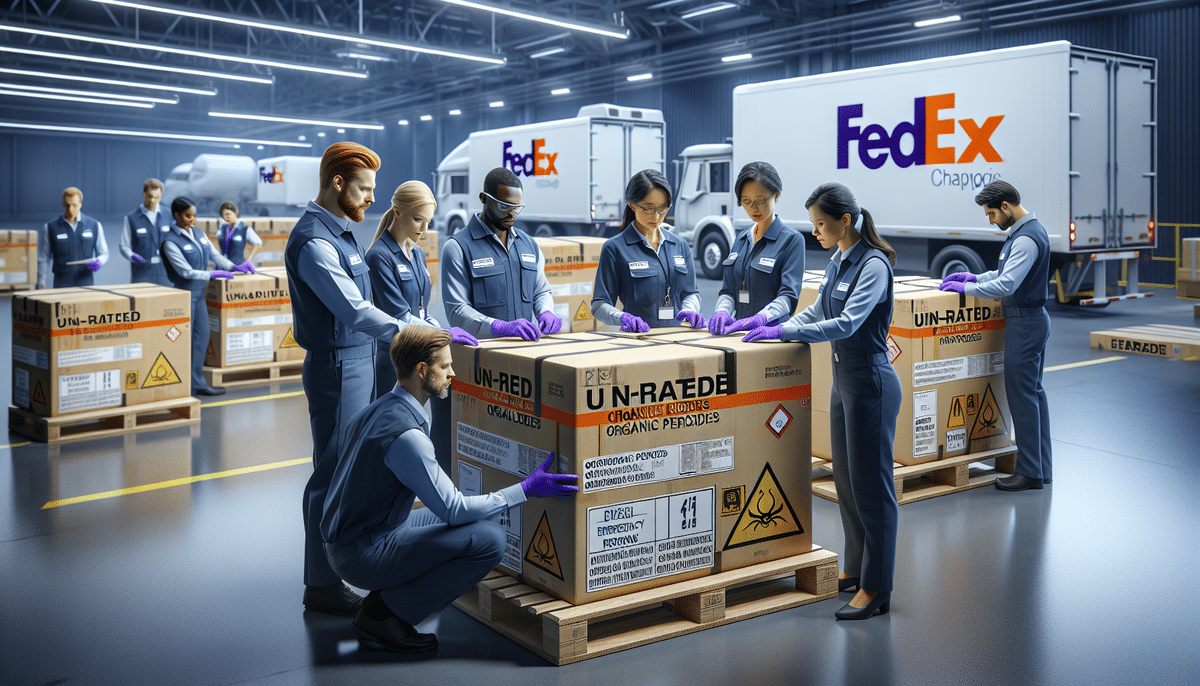FedEx Releases Updated Guidelines for Shipping Organic Peroxides
FedEx, one of the world's leading shipping companies, has released comprehensive and updated guidelines for shipping organic peroxides. Organic peroxides are a class of hazardous materials that pose unique challenges during transportation due to their instability and sensitivity to heat, shock, and friction. Proper packaging and handling are critical to ensuring their safe and timely delivery.
Why Organic Peroxides are Challenging to Ship
Organic peroxides are commonly used as initiators, catalysts, or crosslinking agents in polymerization reactions within industries such as plastics, resins, and adhesives. These highly reactive compounds can undergo exothermic decomposition when exposed to heat or physical stress, potentially leading to fire, explosion, or toxic gas release. Additionally, organic peroxides are sensitive to light, moisture, and contamination, which can degrade their stability and potency.
Due to their hazardous nature, organic peroxides are subject to strict regulations and guidelines for transportation. They must be properly labeled, packaged, and handled to ensure the safety of shippers, carriers, and recipients. The packaging must be designed to withstand potential hazards and prevent leakage or breakage during transit. Furthermore, transporting organic peroxides may require special permits and documentation, as well as trained personnel to handle any emergencies that may arise.
The Importance of Proper Packaging for Organic Peroxides
To minimize the risks associated with transporting organic peroxides, proper packaging is essential. FedEx recommends using UN-rated packaging that meets or exceeds the minimum requirements of the United Nations Recommendations on the Transport of Dangerous Goods (UNRTDG). The packaging must withstand physical shocks, vibrations, and temperature fluctuations during transit. Shippers must also ensure that the packaging is properly marked, labeled, and documented to comply with international and national regulations.
Organic peroxides are highly reactive and can decompose easily, leading to fire or explosion. Therefore, handling and transporting them with extreme caution is imperative. In addition to proper packaging, using specialized carriers trained and equipped to handle dangerous goods is recommended. These carriers must comply with stringent safety regulations and have emergency response plans in place for accidents or incidents during transportation.
FedEx's Comprehensive Guidelines for Shipping Organic Peroxides
FedEx has developed comprehensive guidelines to ensure the safe and reliable shipping of organic peroxides. These guidelines cover a wide range of topics, including:
- Packaging requirements
- Classification and identification of organic peroxides
- Documentation and labeling
- Handling and storage
- Transportation modes and restrictions
- Emergency procedures and contingency plans
According to [Industry Report 2023](https://www.shipscience.com/industry-report-2023), adherence to these guidelines significantly reduces the risk of accidents during transportation. FedEx's protocols ensure that hazardous materials like organic peroxides are handled with the utmost care, providing specific instructions for their proper disposal to minimize environmental impact.
In addition to guidelines, FedEx offers specialized training for employees who handle organic peroxides. This training encompasses topics such as personal protective equipment (PPE), spill response, and emergency procedures, ensuring that employees are well-equipped to handle these materials safely and effectively.
How to Identify and Classify Organic Peroxides for Shipping
Organic peroxides are classified based on their physical properties, reactivity, and hazard potential. They are assigned to one of nine classes depending on their decomposition rate and explosive properties. The shipper must determine the proper classification and packing group of the organic peroxide based on its chemical composition and concentration. FedEx recommends consulting the UNRTDG, the International Air Transport Association (IATA), and the International Maritime Dangerous Goods (IMDG) Code for comprehensive guidance.
It is crucial to recognize that organic peroxides are highly reactive and unstable, posing significant risks during transportation. Proper handling and packaging are vital to ensure the safety of both the shipper and the recipient. Shippers should also be aware of any regulations or restrictions that may apply to the transportation of organic peroxides, such as temperature control requirements or limitations on shipment quantities. By adhering to these guidelines and taking necessary precautions, shippers can safely transport organic peroxides to their intended destinations.
Tips for Safe Handling and Transport of Organic Peroxides
Handling and transporting organic peroxides should be entrusted to trained and authorized personnel familiar with the associated hazards and safety protocols. The following tips can help minimize risks:
- Wear appropriate personal protective equipment (PPE), such as gloves, goggles, and boots
- Avoid smoking, eating, or drinking near organic peroxides
- Prevent exposure to heat, flames, sparks, or static electricity
- Separate incompatible materials and store organic peroxides in cool, dry, and well-ventilated areas
- Ensure that transport vehicles are properly equipped and maintained, with readily available fire extinguishers and spill kits
Organic peroxides can decompose under certain conditions, such as exposure to heat or shock, making it essential to handle and transport them with extreme care. In the event of a spill or leak, following appropriate emergency procedures and contacting relevant authorities immediately is critical. Implementing a spill response plan and conducting regular training and drills can prepare personnel to effectively manage emergency situations.
Understanding the Regulations and Restrictions on Shipping Organic Peroxides
The transportation of organic peroxides is governed by a complex framework of national and international regulations, including the UNRTDG, IATA, IMDG, the US Department of Transportation (DOT), and various country-specific regulations. Shippers must comply with all applicable regulations and obtain necessary permits and approvals to avoid legal penalties, fines, and reputational damage.
Organic peroxides can decompose rapidly, leading to fire or explosion, making correct packaging and labeling paramount for safe transportation. Packaging must be designed to withstand the hazards associated with organic peroxides and tested to meet applicable regulations. Additionally, personnel involved in transportation must receive thorough training on hazards, handling procedures, packaging, labeling, documentation, emergency response, and incident reporting. Proper training helps prevent accidents and ensures the safe transportation of organic peroxides.
What to Do in Case of Accidents or Spills During Organic Peroxide Transportation
Despite rigorous safety measures, accidents or spills involving organic peroxides can occur due to unforeseen circumstances. In such events, shippers must execute emergency procedures and contingency plans to minimize impact and protect human health and the environment. Steps may include:
- Evacuating the area and calling emergency services
- Containing and absorbing the spill with appropriate absorbents
- Neutralizing or disposing of the spill according to regulatory guidelines
- Reporting the incident to appropriate authorities and parties
- Conducting a root cause analysis and implementing corrective actions to prevent future incidents
The response to an organic peroxide spill varies depending on the specific type and quantity involved. Some organic peroxides may require specialized equipment or techniques for containment and cleanup. Therefore, shippers must have a thorough understanding of the properties and hazards of the organic peroxides they transport and have appropriate emergency response plans in place.
Regularly reviewing and updating emergency response plans, as well as providing ongoing training to employees and contractors involved in transportation, can ensure a swift and effective response in the event of an accident or spill, minimizing potential impacts on human health and the environment.
How FedEx is Addressing the Challenges of Shipping Organic Peroxides
FedEx is dedicated to continuously enhancing its operations and services to meet the evolving needs of customers and society. To address the challenges of shipping organic peroxides, FedEx has implemented various measures, including:
- Investing in state-of-the-art packaging and handling technologies
- Providing comprehensive training and certification programs for employees and partners
- Collaborating with industry and regulatory bodies to promote best practices and standards
- Developing sustainable and eco-friendly transportation solutions, such as electric and hydrogen-powered vehicles
Additionally, FedEx has established a dedicated team of experts specializing in hazardous materials, including organic peroxides. This team ensures that all shipments are properly classified, packaged, labeled, and transported in compliance with all applicable regulations and safety standards. FedEx regularly reviews and updates its policies and procedures to incorporate the latest developments in hazardous materials transportation, ensuring that customers receive the highest level of service and protection.
The Future of Safe and Sustainable Transportation for Hazardous Materials like Organic Peroxides
The safe and sustainable transportation of hazardous materials like organic peroxides is a complex and pressing challenge that necessitates a collaborative and innovative approach. The future of transportation is likely to involve the integration of advanced technologies such as artificial intelligence, robotics, and blockchain to optimize the logistics chain and enhance transparency and traceability. A strong commitment to environmental stewardship and social responsibility will be essential to minimize the negative impacts of transportation on the planet and its inhabitants.
One promising solution is the use of autonomous vehicles, which can be programmed to follow specific routes and avoid high population density areas, thereby reducing accident risks and minimizing impacts on surrounding communities. Additionally, the adoption of electric or hybrid vehicles can significantly reduce carbon emissions and improve air quality.
Another critical aspect of safe and sustainable transportation is the proper training and education of personnel involved in the logistics chain, including drivers, handlers, and emergency responders. Equipping them with the knowledge and skills to handle hazardous materials safely and effectively is paramount. Ongoing training and certification programs will help ensure that all personnel remain up-to-date on the latest regulations and best practices for transporting hazardous materials.






















